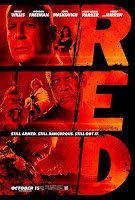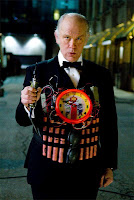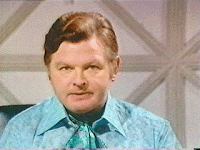Sorry, still running behind.
I’d hoped to do something a little bigger for the ranty blog’s 200th post. Ah, well. We’ll have to celebrate #250. I got to chat with David for an hour or so about working on The Wolfman, the big-budget reimagining of the classic Universal Monster movie. It was definitley a passion project for him (as you’ll see), and he was a lot of fun to speak with. Alas, monster movies don’t do that well these days because too many people go in expecting horror and then blame the film for these expectations.
I got to chat with David for an hour or so about working on The Wolfman, the big-budget reimagining of the classic Universal Monster movie. It was definitley a passion project for him (as you’ll see), and he was a lot of fun to speak with. Alas, monster movies don’t do that well these days because too many people go in expecting horror and then blame the film for these expectations.
Among those things that was challenging is that the whole transforming at the full moon really limits…is a real structural issue that we struggled with for a long time. How to make the plot advance quickly and turn our characters into a werewolf quickly when you’re dealing with this rule of having the full moon.
I’d hoped to do something a little bigger for the ranty blog’s 200th post. Ah, well. We’ll have to celebrate #250.
Here’s one more huge interview with a pro to tide you over until I get my act back together. This time it’s David Self, the screenwriter behind Thirteen Days, Road to Perdition, and The Haunting, among other films. Last I heard, he was working on the adaptation of the God of War videogame.
 I got to chat with David for an hour or so about working on The Wolfman, the big-budget reimagining of the classic Universal Monster movie. It was definitley a passion project for him (as you’ll see), and he was a lot of fun to speak with. Alas, monster movies don’t do that well these days because too many people go in expecting horror and then blame the film for these expectations.
I got to chat with David for an hour or so about working on The Wolfman, the big-budget reimagining of the classic Universal Monster movie. It was definitley a passion project for him (as you’ll see), and he was a lot of fun to speak with. Alas, monster movies don’t do that well these days because too many people go in expecting horror and then blame the film for these expectations. A few points I’ve mentioned before. I’m the one in bold, asking the questions. Also, a lot of these aren’t the exact, word-for-word questions I asked (which tended to be a bit more organic and conversational), so if the answer seems a bit off, don’t stress out over it. A long line of dashes (————-) means there was something there I didn’t transcribe, probably because it was just casual discussion or something I knew I wasn’t going to use in the final article. Any links are entirely mine and aren’t meant to imply David Self endorsed any of the ideas here on the ranty blog. It’s just me linking from something he’s said to something similar I’ve said. And by the very nature of this discussion, there will probably be a few small spoilers in here (although I did cut out one big one). If you haven’t seen the film yet, check it out. It’s fun and you’ll get a bit more out of this discussion.
Also, this is one of the rare cases where I didn’t get to see the fim before my interview (considering I was generally doing interviews two or three months before the films were released). My questions are based off one of David’s earlier drafts I got to read, so you’ll see some back and forth as we establish what does and doesn’t happen in the movie, and why some changes were made.
Material from this interview was originally used for an article that appeared in the January/February 2010 issue of Creative Screenwriting Magazine.
===================================
You work in a lot of different genres as a screenwriter. Horror, drama, political, you’re doing Deathlok for Marvel, I heard… How do you keep from getting pigeonholed?
That’s just IMDb (laughs). I haven’t been working on Deathlok in quite a long time. I did a rewrite on Deathlok.
I guess I actively try to avoid boredom. I want to find new intellectual arenas to challenge myself in. I try to find projects that are different, have a different hue to them, work in different genres. I make an effort to do that. That’s my short answer, and I guess people buy it. (laughs)
How did you end up on The Wolfman?
This came to me from a good friend of mine, a producer, Scott Stuber. I worked with Scott a long time ago. He brought me actually three scripts. Andy’s script, a script by Paul Attanasio, and one Mark Romanek himself had been working on. Kind of in the fall of 2007, just before the strike. Actually, August, late summer.
So there were three actual scripts?
At that point Andy had done what was the main draft. Then they’d hired Paul to do a rewrite. He got about halfway through and didn’t continue. Mark Romanek started to work on it himself. Paul, I think, was working at Mark’s direction at that time, and Mark got halfway through the script as well. So they had two half-scripts and Andy’s script. When I came in I really wanted to work off Andy’s script because it was the most coherent and consistent one. It was a complete script so it was the easiest to start from.
Were you all that familiar with the original?
Oh, yeah. I love the original. The original film is a landmark. It was my dad’s favorite film and I used to watch it with him when I was a kid and knew it well. So there was a little trepidation in going back and trying to come up with a 2010 version of it.
Was it tough shifting the story to a modern day interpretation? Were these things you were dealing with or had Andy dealt with a lot of them already?
Andy had really introduced a lot of the new elements that are in our version of the film. In terms of the father-son dynamic and also, well… (David and I talked about a bunch of spoilerish stuff here that I’m not going to repeat for those of you who haven’t seen the film yet) …That’s a major change from the original, obviously. That idea was an idea Andy introduced. Going back to your question— that was dramatically the biggest adjustment.
So what were some of the issues they brought you in to address? Was it director requests, studio requests, straight script problems?
I think one of the things… In keeping with the original, Andy did well preserving the werewolf lore that the original film introduced to our sense of werewolves. Changing at the full moon, being bitten. Some of the rules we take for granted now. Silver bullets killing werewolves. There were a couple older films… you’d have to do your filmography… that this film all pulled together. Those elements Andy was very particular in preserving, which I think was really important.

Among those things that was challenging is that the whole transforming at the full moon really limits…is a real structural issue that we struggled with for a long time. How to make the plot advance quickly and turn our characters into a werewolf quickly when you’re dealing with this rule of having the full moon.
Yeah, you get four weeks between each action scene.
Exactly (chuckles). So by nature, the earlier drafts of the script had a very extended amount of time before you got to see Benicio del Toro turn into the wolfman. That was really the largest issue that I was brought in to solve–how to speed things up a bit. It was still a very challenging thing, given the rules of our film. That was the largest note that I had to contend with coming into it.
Let me bug you with a couple of process questions before we dive into any more specifics about the film. How do you normally approach a script? Are you an outline guy, a notecard guy?
I generally like to outline, and I try to do the outline in one sitting, so it feels organic, to one moment and impulse. The length of it can vary from a page to ten pages, depending on how much detail I’m seeing right off the bat in my head. I just try to catch the organic impulse of the movie in one moment. And then it mutates from there.
Now was it a lot different for you when you’re coming onto with an existing script, rather than starting from scratch?
Yeah, this is a very different process. It’s a film that is sort of a flashing green light to go. There’s a lot more collaboration. You’re working with a director, a producer, a studio, that all have things they need to achieve to get to where they’re confortable making the film.
Was everyone attached?
Benecio was attached and Mark Romanek was attached. They attached Tony and Emily Blunt after the draft I did in November. And Hugo Weaving. Those guys all came on after. Although Benicio was just sort of… he wasn’t actively involved in development at that point, he was just waiting for us to do our job. ———– I turned in my draft the night before the strike started and that was what they cast off of. And then I was out on the lines
Do you have a lot of writing habits? Do you write so many hours a day or only in the morning?
I’ve become more nocturnal with the advent of four of my children in the past couple years. Prior to that I was more of a workday type of guy. I sort of now have a patched together day, where I work half of the day-day, and then after supper in the eveneing, after the kids go to bed, I have another work period where I tend to be pretty productive. It was different when I was younger.
Do you have a page count you’re trying to hit each day?
More of a scene or sequence objective I set for myself. Not so much a page count. One of the other things I like to do… I get slower as I get closer to the end of the script, because basically I read the script from page one again every day before I start writing again, so I can get everything in my head. It helps me with consistencey issues and voice issues. I don’t have as much reading to do on day two or three, but when I’m getting down to the end I’m spending an hour and a half reading befoe I start writing new stuff.
So was this more of a page one rewrite or a scene-by-scene?
Several scenes, like the sequence in the asylum, I just loved those. There were pieces of Andrew’s writing that I just loved that I just cut and pasted those into the script I was writing. I would tweak a word or two just so it made sense with what came around it. I did start with an empty script when I started rewriting, but I had his sitting next to me the whole time as a reference.
Now, Lawrence would be kind of a grim, haunted figure in this even if he wasn’t bitten by a werewolf. Why change him so much?
Yeah. It’s interesting, the character Andy —– along was a haunted guy who had this sort of gothic, dark back story that preceded the film and becomes uncovered during the course of the film. So he definitely structured that sort of psychological drama in that mode. It was an important decision. It’ll be interesting to see how it translates in the final version of the film, but the notion was this was a guy who had lost himself in theater and burned himself out. He was a guy waiting to be saved.
In the original, Lawrence Talbot is an astronomer, now he’s an actor. Why the change?
That was Andy. He was a guy who was haunted, who lost himself, was estranged from his family and has to come to home. He’s taken on the least manly profession (laughs) in contrast to his father, this big-game hunter, depraved nobility kind of guy.
Was Ben’s murder in the beginning an added scene? Why?
Yeah, we had several different versions of that. I think it was challenging because—— A lot of that changed because of the physicality of the location that we had to work with. There were a couple different versions which we had worked out, given the contingencies of the set. This is the one Joe settled on at the end of the day.
Right in the beginning of this story you’ve got the old man on the train with the silver cane. Why this odd device of a complete stranger who never figures into the story again?
Yeah, that version hasn’t made it into the final film. We had a notion that this was not just an old guy, but there was this sort of implication that the creepy old guy could be Satan passing the cane along. It didn’t make it (laugh), he just has the cane in the current film. I thought it was just a good idea, it’s just his from the start now. With the 2010 kicker of it being a sword.——I definitely tried to find a few places of connection for little spiritual totems of the original.
What about the connection between Aberline and Jack the Ripper?
Yeah (laughs). Aberline was introduced in Paul’s draft as a pursuing character that then we fleshed out. He chose the name Aberline. I didn’t really connect that with that notion when I first read it, but then I looked up the name and said ‘Oh, this is the guy from In Hell!’ (laughs) We thought that was a fun grace note to have.
——-No. I mean, Paul didn’t bring it up that he’d been involved in the Ripper case previously. We added that dimension to it.
Benicio Del Toro has been known to rewrite a script or two. Did he have a lot of notes for you?
(laughs). No, he didn’t. Not the script. Benny is sort of… the process in independent films is a little bit different than this sort of film. He didn’t rewrite anything but we had lots of conversations about his dialogue. He certainly wanted to plumb his lines and stuff like that. Not rewriting per se, but he had a lot of ‘Could I say it this way…?’ He’s a real professional.
Without giving too much away for the readers… there’s a big switch in how Lawrence becomes the werewolf.
I think as soon as you see Benicio del Toro and Anthony Hopkins are both in this film… (laughs). I think the audience gets some satisfaction about having their suspiciions confirmed. I think his sense of betrayal is a good thing. Rather than it just being (chuckles) Bela Legosi, just some guy who randomly bites him. I thought this was a good, meaningful melodrama.
Is it tough to do spoiler-dependent films these days?
Knowing that you’re going to be outed? (chuckles). Yes and no. I think it’d be much harder to pull off a Sixth Sense-style film these days that really depended upon that surprise. I think that would be very difficult to pull off now. On the other hand, if you’re creating enough engagement and suspense in the moment, you can know the outcome of a film. Something like Thirteen Days. You’re sitting in the theater so you know the world hasn’t blown up. But you can create tensions and suspense, and if you’re doing your job, in the moment people will forget that fact. ——–
—That’s the magic of it, that you can suspend disbelief there. Watching something that’s well-told you can forget that you already know certain aspects of it. There’s something anthropologically gratifyying about that to me. The yarn-weaving and the storytelling is the social, fun experience, not the knowledge itself.
Would you say this film is horror or more of an action-adventure story?
I think it’s a classic Universal monster movie. I think there’s a little bit of difference between a horror film and a monster movie. This has got that broader pallate that you’re talking about. I think it straddles that. It’s got horror elements in a bigger action-adventure film.
Last question. I know this sounds silly but… why one word? The original Chaney is two, The Wolf Man. Is that just some oddity that cropped up?
By the production! I’m so furious! (laughs) Every single draft and every single email I write to this day, I still write two words,”Wolf Man,” because I just can’t accept the fact that they’ve condensed the title. I don’t know how it happened. I don’t know where it happened. It just was a spiral thing that began, I think, in the production. Somebody compressed it and I’ve fought against it. It’s not a silly question, it’s my pet jihad!









